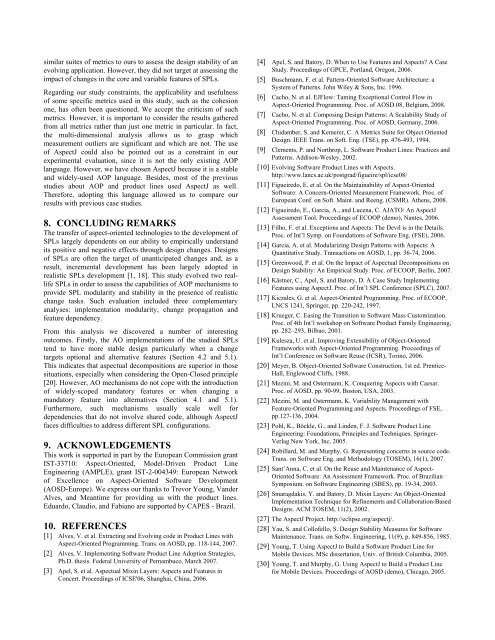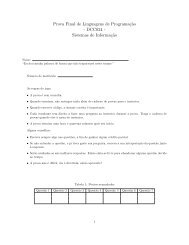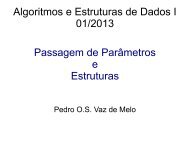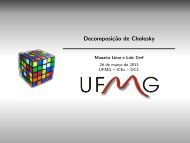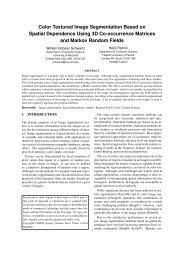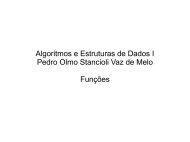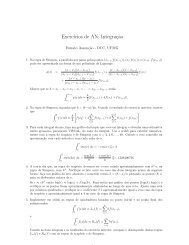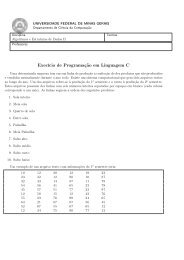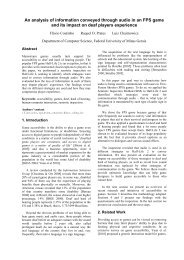Evolving Software Product Lines with Aspects: An Empirical ... - UFMG
Evolving Software Product Lines with Aspects: An Empirical ... - UFMG
Evolving Software Product Lines with Aspects: An Empirical ... - UFMG
Create successful ePaper yourself
Turn your PDF publications into a flip-book with our unique Google optimized e-Paper software.
similar suites of metrics to ours to assess the design stability of an<br />
evolving application. However, they did not target at assessing the<br />
impact of changes in the core and variable features of SPLs.<br />
Regarding our study constraints, the applicability and usefulness<br />
of some specific metrics used in this study, such as the cohesion<br />
one, has often been questioned. We accept the criticism of such<br />
metrics. However, it is important to consider the results gathered<br />
from all metrics rather than just one metric in particular. In fact,<br />
the multi-dimensional analysis allows us to grasp which<br />
measurement outliers are significant and which are not. The use<br />
of AspectJ could also be pointed out as a constraint in our<br />
experimental evaluation, since it is not the only existing AOP<br />
language. However, we have chosen AspectJ because it is a stable<br />
and widely-used AOP language. Besides, most of the previous<br />
studies about AOP and product lines used AspectJ as well.<br />
Therefore, adopting this language allowed us to compare our<br />
results <strong>with</strong> previous case studies.<br />
8. CONCLUDING REMARKS<br />
The transfer of aspect-oriented technologies to the development of<br />
SPLs largely dependents on our ability to empirically understand<br />
its positive and negative effects through design changes. Designs<br />
of SPLs are often the target of unanticipated changes and, as a<br />
result, incremental development has been largely adopted in<br />
realistic SPLs development [1, 18]. This study evolved two reallife<br />
SPLs in order to assess the capabilities of AOP mechanisms to<br />
provide SPL modularity and stability in the presence of realistic<br />
change tasks. Such evaluation included three complementary<br />
analyses: implementation modularity, change propagation and<br />
feature dependency.<br />
From this analysis we discovered a number of interesting<br />
outcomes. Firstly, the AO implementations of the studied SPLs<br />
tend to have more stable design particularly when a change<br />
targets optional and alternative features (Section 4.2 and 5.1).<br />
This indicates that aspectual decompositions are superior in those<br />
situations, especially when considering the Open-Closed principle<br />
[20]. However, AO mechanisms do not cope <strong>with</strong> the introduction<br />
of widely-scoped mandatory features or when changing a<br />
mandatory feature into alternatives (Section 4.1 and 5.1).<br />
Furthermore, such mechanisms usually scale well for<br />
dependencies that do not involve shared code, although AspectJ<br />
faces difficulties to address different SPL configurations.<br />
9. ACKNOWLEDGEMENTS<br />
This work is supported in part by the European Commission grant<br />
IST-33710: Aspect-Oriented, Model-Driven <strong>Product</strong> Line<br />
Engineering (AMPLE), grant IST-2-004349: European Network<br />
of Excellence on Aspect-Oriented <strong>Software</strong> Development<br />
(AOSD-Europe). We express our thanks to Trevor Young, Vander<br />
Alves, and Meantime for providing us <strong>with</strong> the product lines.<br />
Eduardo, Claudio, and Fabiano are supported by CAPES - Brazil.<br />
10. REFERENCES<br />
[1] Alves, V. et al. Extracting and <strong>Evolving</strong> code in <strong>Product</strong> <strong>Lines</strong> <strong>with</strong><br />
Aspect-Oriented Programming. Trans. on AOSD, pp. 118-144, 2007.<br />
[2] Alves, V. Implementing <strong>Software</strong> <strong>Product</strong> Line Adoption Strategies,<br />
Ph.D. thesis. Federal University of Pernambuco, March 2007.<br />
[3] Apel, S. et al. Aspectual Mixin Layers: <strong>Aspects</strong> and Features in<br />
Concert. Proceedings of ICSE'06, Shanghai, China, 2006.<br />
[4] Apel, S. and Batory, D. When to Use Features and <strong>Aspects</strong>? A Case<br />
Study. Proceedings of GPCE, Portland, Oregon, 2006.<br />
[5] Buschmann, F. et al. Pattern-Oriented <strong>Software</strong> Architecture: a<br />
System of Patterns. John Wiley & Sons, Inc. 1996.<br />
[6] Cacho, N. et al. EJFlow: Taming Exceptional Control Flow in<br />
Aspect-Oriented Programming. Proc. of AOSD.08, Belgium, 2008.<br />
[7] Cacho, N. et al. Composing Design Patterns: A Scalability Study of<br />
Aspect-Oriented Programming. Proc. of AOSD, Germany, 2006.<br />
[8] Chidamber, S. and Kemerer, C. A Metrics Suite for Object Oriented<br />
Design. IEEE Trans. on Soft. Eng. (TSE), pp. 476-493, 1994.<br />
[9] Clements, P. and Northrop, L. <strong>Software</strong> <strong>Product</strong> <strong>Lines</strong>: Practices and<br />
Patterns. Addison-Wesley, 2002.<br />
[10] <strong>Evolving</strong> <strong>Software</strong> <strong>Product</strong> <strong>Lines</strong> <strong>with</strong> <strong>Aspects</strong>.<br />
http://www.lancs.ac.uk/postgrad/figueire/spl/icse08/<br />
[11] Figueiredo, E. et al. On the Maintainability of Aspect-Oriented<br />
<strong>Software</strong>: A Concern-Oriented Measurement Framework. Proc. of<br />
European Conf. on Soft. Maint. and Reeng. (CSMR). Athens, 2008.<br />
[12] Figueiredo, E., Garcia, A., and Lucena, C. AJATO: <strong>An</strong> AspectJ<br />
Assessment Tool. Proceedings of ECOOP (demo), Nantes, 2006.<br />
[13] Filho, F. et al. Exceptions and <strong>Aspects</strong>: The Devil is in the Details.<br />
Proc. of Int’l Symp. on Foundations of <strong>Software</strong> Eng. (FSE), 2006.<br />
[14] Garcia, A. et al. Modularizing Design Patterns <strong>with</strong> <strong>Aspects</strong>: A<br />
Quantitative Study. Transactions on AOSD, 1, pp. 36-74, 2006.<br />
[15] Greenwood, P. et al. On the Impact of Aspectual Decompositions on<br />
Design Stability: <strong>An</strong> <strong>Empirical</strong> Study. Proc. of ECOOP, Berlin, 2007.<br />
[16] Kästner, C., Apel, S. and Batory, D. A Case Study Implementing<br />
Features using AspectJ. Proc. of Int’l SPL Conference (SPLC), 2007.<br />
[17] Kiczales, G. et al. Aspect-Oriented Programming. Proc. of ECOOP,<br />
LNCS 1241, Springer, pp. 220-242, 1997.<br />
[18] Krueger, C. Easing the Transition to <strong>Software</strong> Mass Customization.<br />
Proc. of 4th Int’l workshop on <strong>Software</strong> <strong>Product</strong> Family Engineering,<br />
pp. 282–293, Bilbao, 2001.<br />
[19] Kulesza, U. et al. Improving Extensibility of Object-Oriented<br />
Frameworks <strong>with</strong> Aspect-Oriented Programming. Proceedings of<br />
Int’l Conference on <strong>Software</strong> Reuse (ICSR), Torino, 2006.<br />
[20] Meyer, B. Object-Oriented <strong>Software</strong> Construction, 1st ed. Prentice-<br />
Hall, Englewood Cliffs, 1988.<br />
[21] Mezini, M. and Ostermann, K. Conquering <strong>Aspects</strong> <strong>with</strong> Caesar.<br />
Proc. of AOSD, pp. 90-99, Boston, USA, 2003.<br />
[22] Mezini, M. and Ostermann, K. Variability Management <strong>with</strong><br />
Feature-Oriented Programming and <strong>Aspects</strong>. Proceedings of FSE,<br />
pp.127-136, 2004.<br />
[23] Pohl, K., Böckle, G., and Linden, F. J. <strong>Software</strong> <strong>Product</strong> Line<br />
Engineering: Foundations, Principles and Techniques. Springer-<br />
Verlag New York, Inc, 2005.<br />
[24] Robillard, M. and Murphy, G. Representing concerns in source code.<br />
Trans. on <strong>Software</strong> Eng. and Methodology (TOSEM), 16(1), 2007.<br />
[25] Sant’<strong>An</strong>na, C. et al. On the Reuse and Maintenance of Aspect-<br />
Oriented <strong>Software</strong>: <strong>An</strong> Assessment Framework. Proc. of Brazilian<br />
Symposium. on <strong>Software</strong> Engineering (SBES), pp. 19-34, 2003.<br />
[26] Smaragdakis, Y. and Batory, D. Mixin Layers: <strong>An</strong> Object-Oriented<br />
Implementation Technique for Refinements and Collaboration-Based<br />
Designs. ACM TOSEM, 11(2), 2002.<br />
[27] The AspectJ Project. http://eclipse.org/aspectj/.<br />
[28] Yau, S. and Collofello, S. Design Stability Measures for <strong>Software</strong><br />
Maintenance. Trans. on Softw. Engineering, 11(9), p. 849-856, 1985.<br />
[29] Young, T. Using AspectJ to Build a <strong>Software</strong> <strong>Product</strong> Line for<br />
Mobile Devices. MSc dissertation, Univ. of British Columbia, 2005.<br />
[30] Young, T. and Murphy, G. Using AspectJ to Build a <strong>Product</strong> Line<br />
for Mobile Devices. Proceedings of AOSD (demo), Chicago, 2005.


